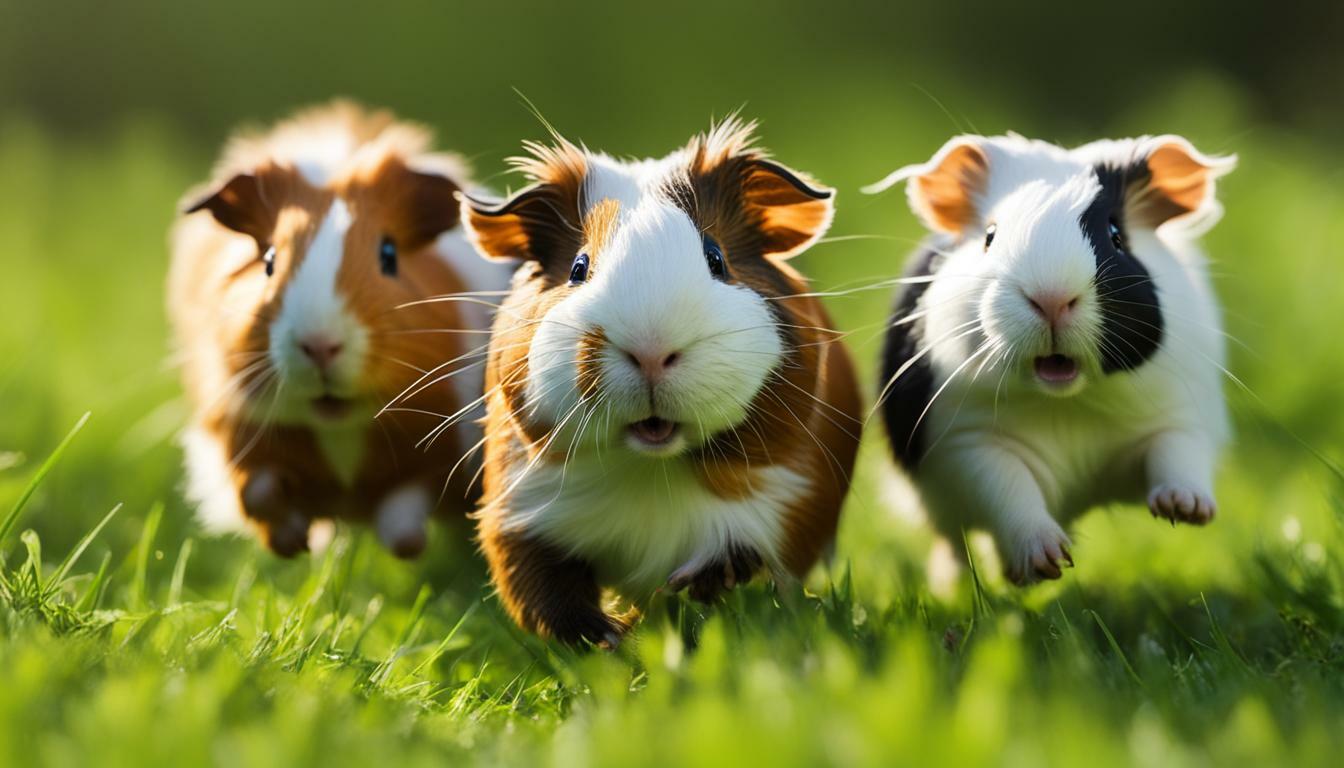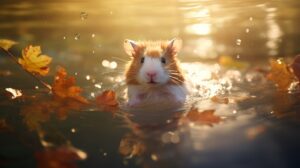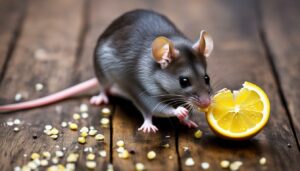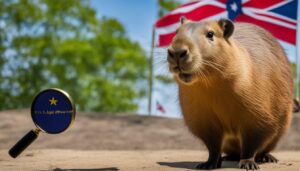Guinea pigs are capable of running at impressive speeds, but just how fast can they go? Understanding the speed and running abilities of guinea pigs can help provide them with the right environment and care to support their natural instincts.
Key Takeaways:
- Guinea pigs can run at an average speed of 8 to 10 miles per hour (13 to 16 kilometers per hour).
- Their speed is influenced by factors like breed, age, fitness level, and environment.
- Different guinea pig breeds have varying levels of agility and speed, with Abyssinian and Peruvian breeds known for their swiftness.
- Younger guinea pigs are generally more active and can run faster than older ones.
- Providing a spacious and stimulating environment, regular exercise, and a balanced diet contribute to their speed and agility.
Factors Affecting Guinea Pig Speed
The speed at which a guinea pig can run is influenced by several factors that vary from one guinea pig to another. Breed, age, fitness level, and environment all play a role in determining a guinea pig’s speed and running ability.
Breed: Different guinea pig breeds have varying levels of agility and speed. For example, the Abyssinian and Peruvian breeds are known to be swifter than others. These breeds have sleeker bodies and longer legs, which contribute to their faster running abilities.
Age: Younger guinea pigs are generally more active and energetic, which allows them to run at higher speeds. As they age, guinea pigs may become less active and their running speed may decrease.
Fitness Level: Just like humans, guinea pigs’ fitness levels affect their running ability. Regular exercise and a balanced diet are crucial in maintaining their overall health and agility. If a guinea pig is overweight or sedentary, it may not be able to run as fast as a healthier, more active guinea pig.
Environment: Providing a spacious and stimulating environment for guinea pigs is essential in encouraging their natural sprinting instincts. A cage with ample space and engaging toys will give them the opportunity to run and play, which can improve their overall running ability.
While domestic guinea pigs may not be as fast as their wild counterparts, they can still reach impressive speeds of up to 6 meters per second (13.4 miles per hour). Despite their natural instinct to run and jump, guinea pigs typically reserve these behaviors for sudden bursts of happiness or energy. It is important to provide a safe and supervised play area for guinea pigs to exercise outside their cages, as they are vulnerable to injuries and accidents.
| Factors | Speed Influence |
|---|---|
| Breed | Different breeds have varying levels of agility and speed. Some breeds, like Abyssinian and Peruvian, are known to be swifter. |
| Age | Youthful guinea pigs are generally more active and can run faster, while older guinea pigs may have decreased speed and activity levels. |
| Fitness Level | A healthier and more active guinea pig will have better running ability than a sedentary or overweight one. |
| Environment | A spacious and stimulating environment, with ample space and engaging toys, encourages guinea pigs’ natural sprinting instincts. |
In conclusion, while the speed at which guinea pigs can run varies, factors such as breed, age, fitness level, and environment all contribute to their running ability. Providing a suitable environment, regular exercise, and a balanced diet are important in maintaining their speed and agility. Remember to create a safe and supervised play area for guinea pigs to exercise, as they may be vulnerable to accidents and injuries.
Guinea Pig Breeds and Speed
Not all guinea pigs are created equal when it comes to speed, as different breeds exhibit different levels of agility and running ability. Some breeds, such as Abyssinian and Peruvian, are known for their swiftness and can reach impressive speeds. These breeds have sleek and slender body types, which allow them to move quickly and gracefully. On the other hand, breeds with bulkier body types, like the American and Teddy, may not be as fast but still possess their own charm.
To better understand the speed and agility of different guinea pig breeds, let’s take a look at a table that compares the top speeds of selected breeds:
| Breed | Top Speed |
|---|---|
| Abyssinian | Up to 15 mph (24 km/h) |
| Peruvian | Up to 14 mph (22.5 km/h) |
| American | Up to 10 mph (16 km/h) |
| Teddy | Up to 9 mph (14.5 km/h) |
Other Factors Influencing Speed
While breed plays a significant role in a guinea pig’s speed, there are other factors to consider as well. Age is one such factor, with younger guinea pigs often being more active and capable of running faster than their older counterparts. Fitness level is also key, as guinea pigs that engage in regular exercise and have a balanced diet are generally more agile and quick on their feet. Additionally, the environment in which a guinea pig is kept can impact its speed and overall health. Providing a spacious and stimulating cage, equipped with toys and hiding spots, encourages their natural running instincts.
It’s important to remember that guinea pigs are not natural sprinters like some other animals. They typically reserve their bursts of speed for moments of excitement or sudden bursts of energy. Nonetheless, observing your guinea pig running and jumping can bring joy and excitement to both you and your furry friend. Just ensure that any play areas outside their cage are safe and supervised, as guinea pigs are prone to injuries and accidents.
Age and Speed
Age plays a role in a guinea pig’s speed, with younger guinea pigs typically being more energetic and quicker on their feet. As guinea pigs grow older, they may become less active, which can affect their overall speed and agility. Younger guinea pigs have more stamina and are more likely to engage in playful running and jumping behaviors, showcasing their natural athleticism.
It’s important to note that even though younger guinea pigs are generally faster, the specific speed can still vary among individuals. Factors such as breed, overall health, and fitness level also contribute to how fast a guinea pig can run, regardless of age. Providing them with a balanced diet, regular exercise, and a stimulating environment can help maintain their speed and agility as they age.
To understand the impact of age on a guinea pig’s speed, it can be helpful to look at a comparison table:
| Age | Speed (miles per hour) |
|---|---|
| 0-6 months | 10-13 |
| 6-12 months | 8-11 |
| 1-2 years | 7-9 |
| 2+ years | 6-8 |
As guinea pigs age, their speed gradually decreases, but they can still enjoy running and exercise throughout their lives. It’s essential to provide a safe and supervised play area for guinea pigs, both inside and outside their cages, to prevent injuries and accidents. Regular interaction and playtime with their human caregivers also contribute to their overall happiness and well-being.
Providing the Right Environment for Speed
Creating an environment that allows guinea pigs to run at their full speed is crucial for their physical and mental well-being. These small furry creatures are naturally active and enjoy sprinting as part of their instinctive behavior. To ensure they can exhibit their natural running abilities, it is important to provide them with a spacious and stimulating living space.
A guinea pig enclosure should offer ample room for them to move around freely and reach their top speed. A cage that is at least 7.5 square feet in size is recommended for a single guinea pig, and larger if you have multiple guinea pigs. Additionally, including tunnels, ramps, and platforms in their enclosure can create an engaging and dynamic environment, encouraging them to explore and run.
Adding interactive toys and obstacles can further stimulate their running instincts. You can include tunnels, balls, and bridges for them to navigate, allowing them to enjoy a game of running and chasing. These toys not only provide physical exercise but also mental stimulation, keeping them active and entertained.
| Environmental Factors for Optimal Speed | Recommendations |
|---|---|
| Enclosure Size | A minimum of 7.5 square feet for a single guinea pig |
| Enrichment Toys | Tunnels, balls, bridges to encourage running and exploration |
| Safe Play Area | A supervised space outside the cage for additional exercise |
| Obstacle Course | Incorporate ramps, platforms, and tunnels for added stimulation |
While an enriched enclosure provides opportunities for exercise, it is also important to allow guinea pigs to explore outside their cages under supervision. However, it is crucial to create a safe and secure play area, free from hazards or potential escape routes. Ensure the area is enclosed, and supervise their playtime to prevent accidents or injuries.
By providing a suitable environment that allows guinea pigs to run and play, you are not only promoting their physical well-being but also supporting their mental stimulation and happiness. So, go ahead and create an exciting space where your guinea pigs can unleash their natural running abilities and enjoy their sprinting adventures!
Exercise and Diet for Speed and Agility
Regular exercise and a nutritious diet are essential for maximizing a guinea pig’s running ability and overall physical fitness. Providing opportunities for exercise helps to stimulate their natural instincts and maintain a healthy weight. A sedentary lifestyle can lead to weight gain and reduced agility, so it’s important to create a suitable environment for them to stay active.
Guinea pigs should have access to a spacious cage that allows them to move around freely. Including tunnels, ramps, and platforms in their enclosure can also provide additional exercise and mental stimulation. Ensuring they have room to explore and run can help them build strength, endurance, and speed.
In addition to exercise, a well-balanced diet is crucial for a guinea pig’s overall health and running ability. Their diet should consist of fresh hay, high-quality pellets, and a variety of fresh vegetables and fruits. These foods provide the necessary nutrients, vitamins, and minerals to support their energy levels and keep their muscles strong.
| Exercise Tips | Diet Tips |
|---|---|
|
|
Remember to introduce any changes in exercise or diet gradually, as guinea pigs have sensitive digestive systems. It’s important to monitor their overall well-being and consult with a veterinarian if you have any concerns about their health or running ability.
Comparing Domestic and Wild Guinea Pigs
Domestic guinea pigs may not match the lightning-fast speed of their wild relatives, but they can still reach impressive velocities. While wild guinea pigs can sprint at speeds of up to 35 miles per hour (56 kilometers per hour), domestic guinea pigs typically reach top speeds of around 13.4 miles per hour (21.6 kilometers per hour). Despite this difference, domestic guinea pigs can still exhibit bursts of energy and enjoyment when running.
It is important to note that guinea pigs, whether domestic or wild, do not sprint frequently. Running is typically reserved for moments of happiness or energy release. Guinea pigs are more prone to walking, exploring their surroundings, and engaging in calmer activities. However, providing a safe and supervised play area for guinea pigs outside their cages allows them to exercise and express their natural urge to run and explore.
While wild guinea pigs have adapted to life in their natural habitats and have developed incredible speed, domestic guinea pigs have been selectively bred for certain traits, such as temperament and appearance. As a result, their speed may not be as remarkable, but they still possess the ability to reach impressive speeds within their own capabilities.
| Wild Guinea Pigs | Domestic Guinea Pigs | |
|---|---|---|
| Top Speed | Up to 35 mph (56 km/h) | Up to 13.4 mph (21.6 km/h) |
| Running Frequency | Occasional sprints for survival | Occasional bursts of happiness or energy |
| Adaptation | Natural selection for survival in the wild | Selective breeding for desired traits |
Summary:
- Wild guinea pigs can run up to 35 mph, while domestic guinea pigs can reach speeds of up to 13.4 mph.
- Both domestic and wild guinea pigs do not sprint frequently, reserving running for moments of happiness or energy release.
- Domestic guinea pigs have been selectively bred for specific traits, which may result in slightly slower speeds compared to their wild counterparts.
Providing a stimulating environment, regular exercise, and a balanced diet are essential for maintaining a guinea pig’s speed, agility, and overall health, regardless of their domestication. It is important to create a safe and supervised play area for guinea pigs to fulfill their natural instinct to run and jump while minimizing the risk of accidents or injuries.
Running and Jumping Instincts
Running and jumping are innate behaviors in guinea pigs, rooted in their wild ancestry and ingrained in their instincts. These small rodents have a natural inclination to move swiftly and effortlessly, displaying bursts of energy as they race and leap through their environment. While guinea pigs are not known for their speed, their running and jumping abilities are still fascinating to observe.
Guinea pigs, like their wild ancestors, possess strong hind limbs that propel them forward in quick bursts. Their muscular legs and agile bodies allow them to navigate obstacles and make sudden turns with ease. These instinctual behaviors are not only a means of exercise but also serve as a form of communication and expression of happiness.
Although guinea pigs are not marathon runners, they do enjoy short sprints, especially when they feel excited or stimulated. You may notice your furry friend running in circles or darting around their cage, showcasing their playful nature. It’s important to provide them with a safe and supervised play area outside of their cages, as guinea pigs can be prone to accidents and injuries when running freely.
Table: Common Running and Jumping Behaviors in Guinea Pigs
| Behavior | Description |
|---|---|
| Zoomies | Rapid bursts of quick, erratic running and jumping, often in circles or back and forth. |
| Popcorning | Excited jumps in the air with a twisting motion, accompanied by joyful squeaks. |
| Leaping | Elevating the body off the ground with a powerful push from the hind legs. |
| Running in Tunnels | Navigating tunnels and tubes with impressive speed and agility. |
While guinea pigs may not have the impressive speed of other animals, their running and jumping instincts are a delightful part of their behavior that brings joy to both owners and observers. So, create an environment that allows your guinea pig to engage in these natural behaviors, and enjoy watching them express their exuberance and zest for life.
Conclusion
Guinea pigs may not be the fastest creatures on Earth, but their average speed of 8 to 10 miles per hour showcases their impressive running ability. Factors such as breed, age, fitness level, and environment all play a role in determining how fast a guinea pig can run. Different guinea pig breeds exhibit varying levels of agility and speed, with breeds like Abyssinian and Peruvian known for their swiftness.
Younger guinea pigs are generally more active and can outpace their older counterparts. It is important to provide guinea pigs with a spacious and stimulating environment, such as a cage with ample space and engaging toys, to encourage their natural sprinting instincts. Regular exercise, a balanced diet, and overall health maintenance also contribute to their speed and agility.
While domestic guinea pigs are slower than their wild counterparts, they can still reach speeds of up to 6 meters per second (13.4 miles per hour). Running and jumping are instinctual behaviors inherited from their wild nature. However, guinea pigs do not sprint frequently and typically reserve it for sudden bursts of happiness or energy.
When allowing guinea pigs to exercise outside their cages, it is crucial to provide a safe and supervised play area. Guinea pigs are vulnerable to injuries and accidents, so it’s essential to ensure their playtime is monitored and free from potential hazards.
FAQ
How fast can guinea pigs run?
Guinea pigs can run at an average speed of 8 to 10 miles per hour (13 to 16 kilometers per hour).
What factors affect guinea pig speed?
Factors like breed, age, fitness level, and environment influence a guinea pig’s speed.
Do different guinea pig breeds have different speeds?
Yes, different guinea pig breeds have varying levels of speed and agility. Breeds like Abyssinian and Peruvian are known for their swiftness.
How does age affect a guinea pig’s speed?
Younger guinea pigs are generally more active and can run faster than older ones.
What kind of environment encourages guinea pigs to run?
Providing a spacious and stimulating environment, such as a cage with ample space and engaging toys, encourages their natural sprinting instincts.
How does exercise and diet contribute to guinea pig speed and agility?
Regular exercise, a balanced diet, and maintaining overall health contribute to a guinea pig’s speed and agility.
How does the speed of domestic guinea pigs compare to wild guinea pigs?
Domestic guinea pigs are generally slower than their wild counterparts but can still reach speeds of up to 6 meters per second (13.4 miles per hour).
Do guinea pigs run and jump often?
Guinea pigs enjoy running and jumping but typically reserve it for sudden bursts of happiness or energy.
Are there any precautions to take when allowing guinea pigs to run outside their cages?
It is important to provide a safe and supervised play area for guinea pigs to exercise outside their cages, as they are vulnerable to injuries and accidents.




